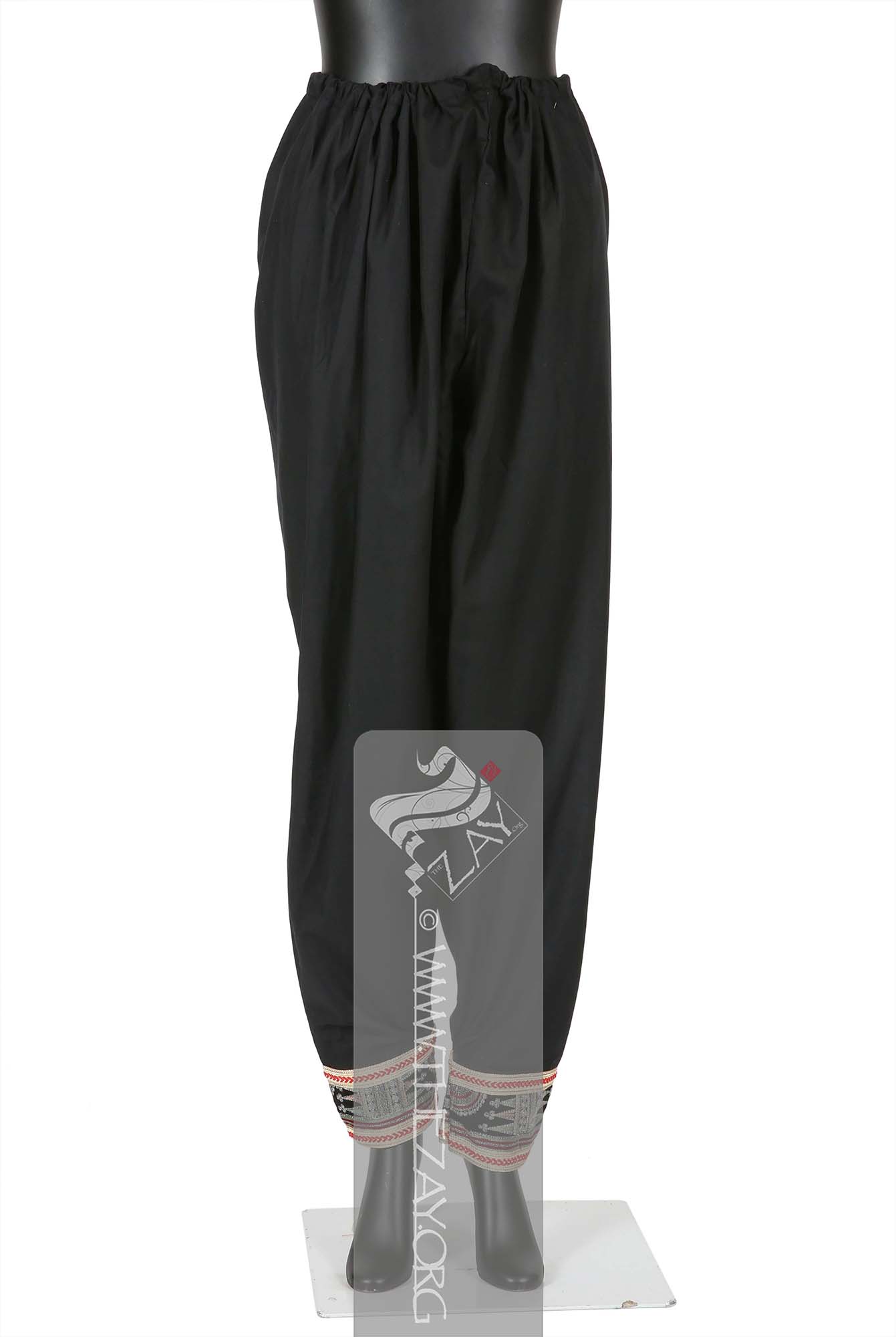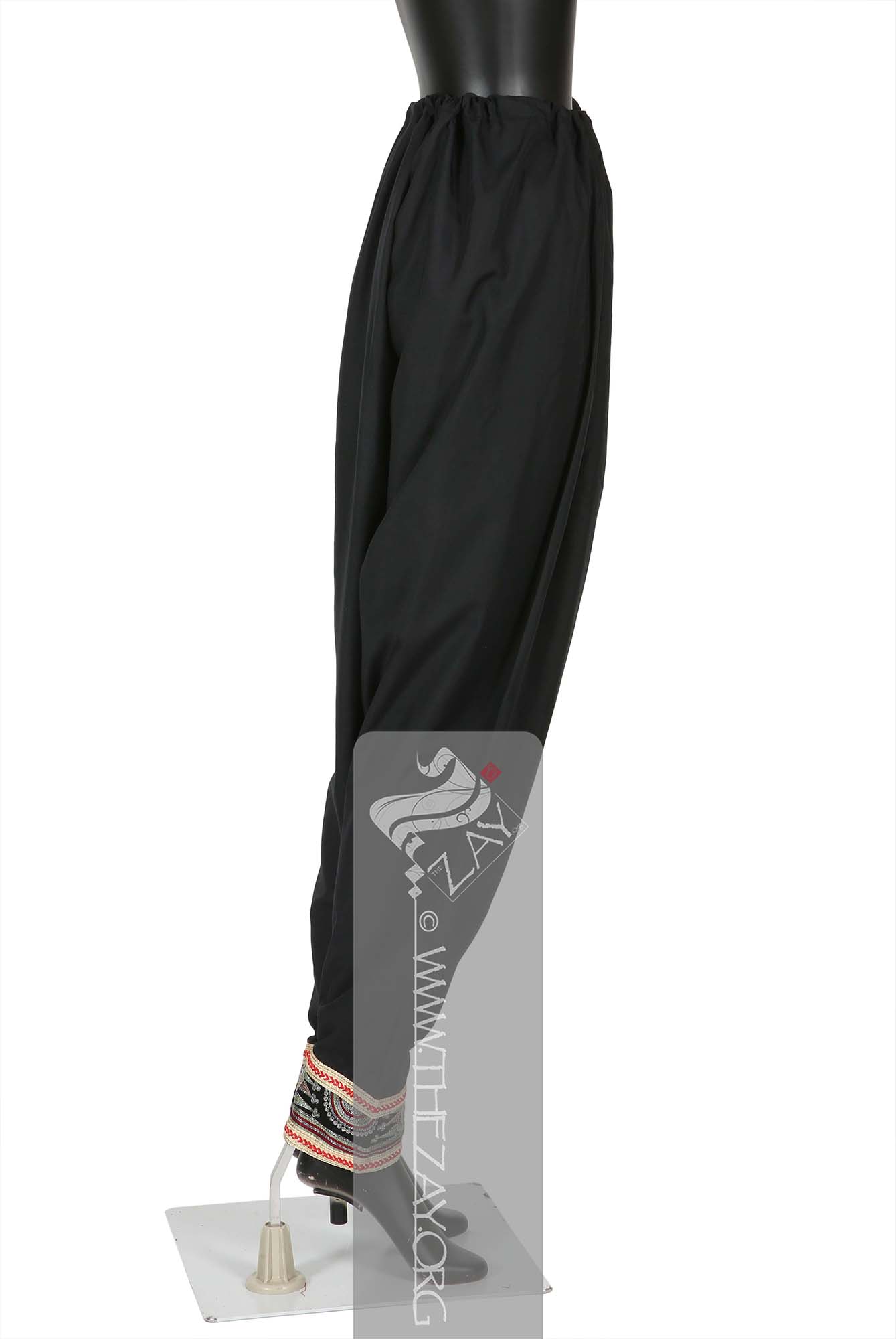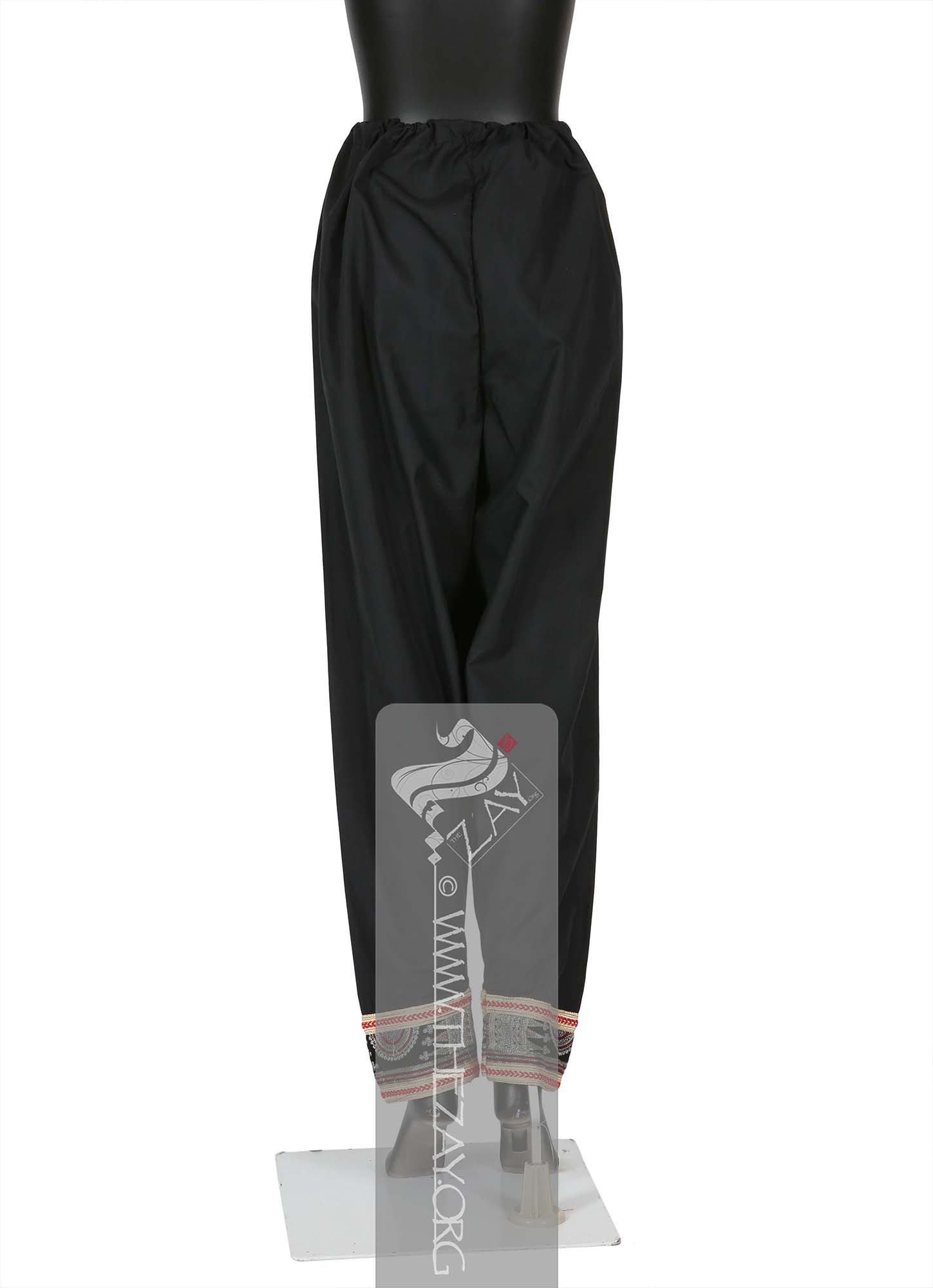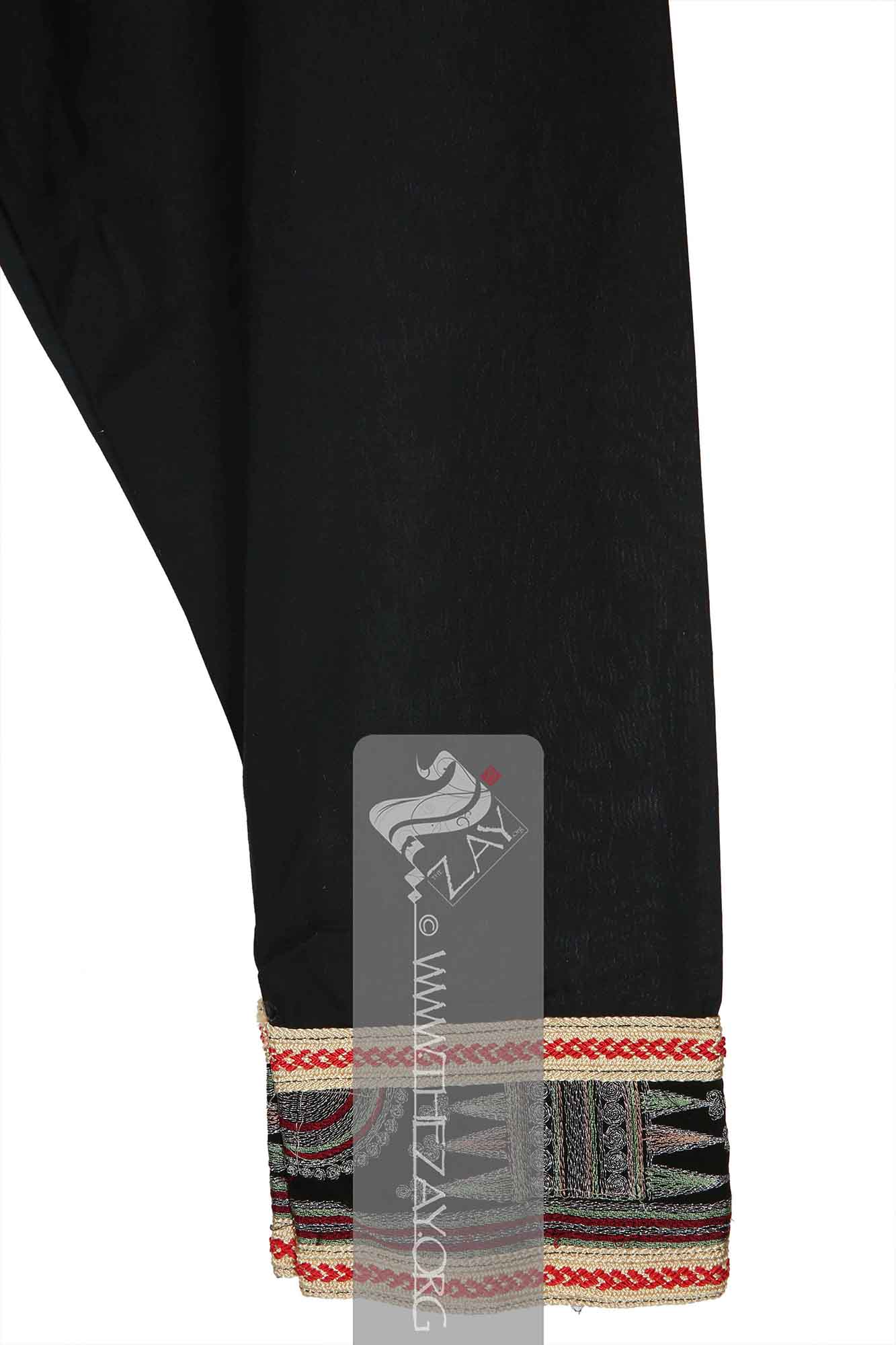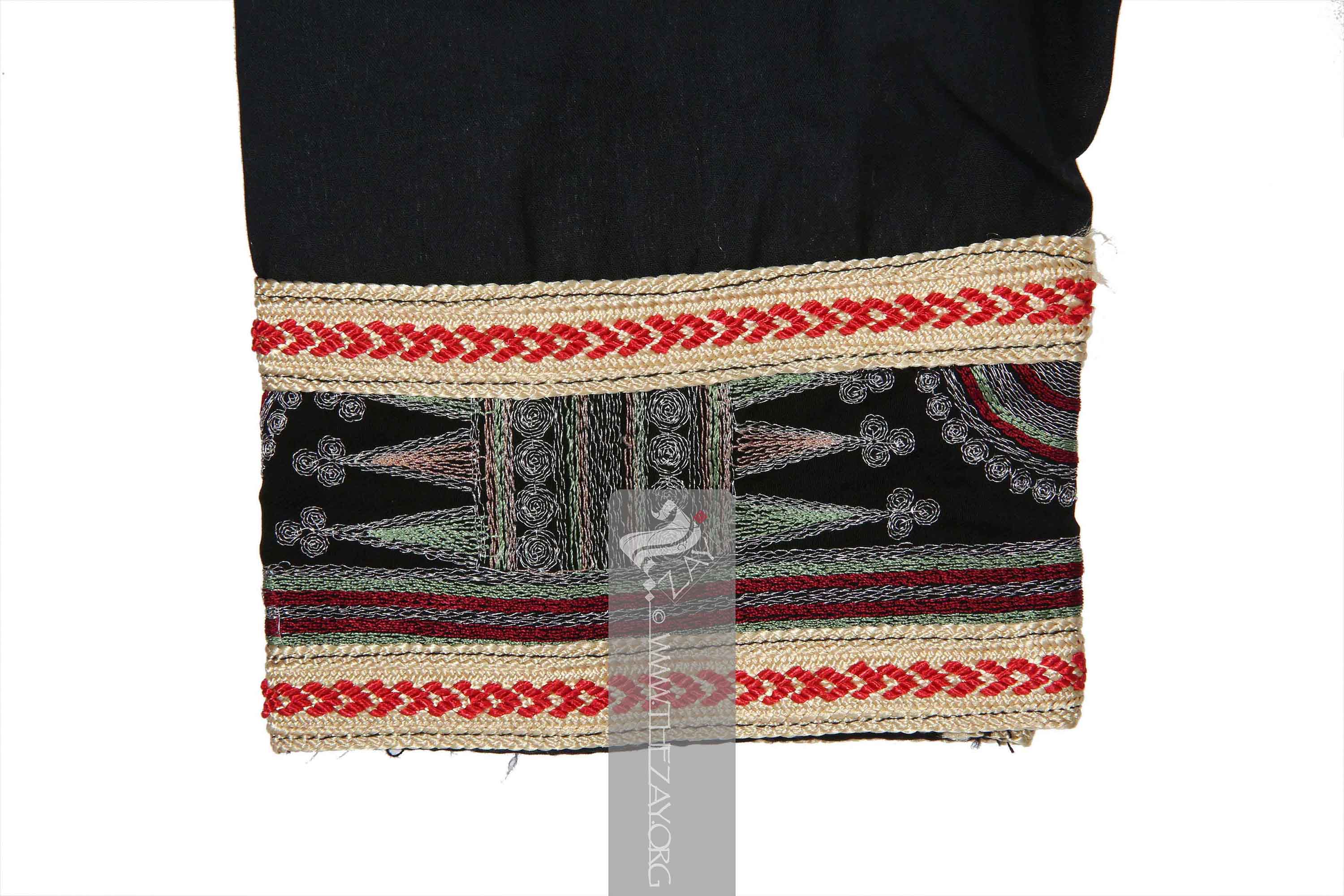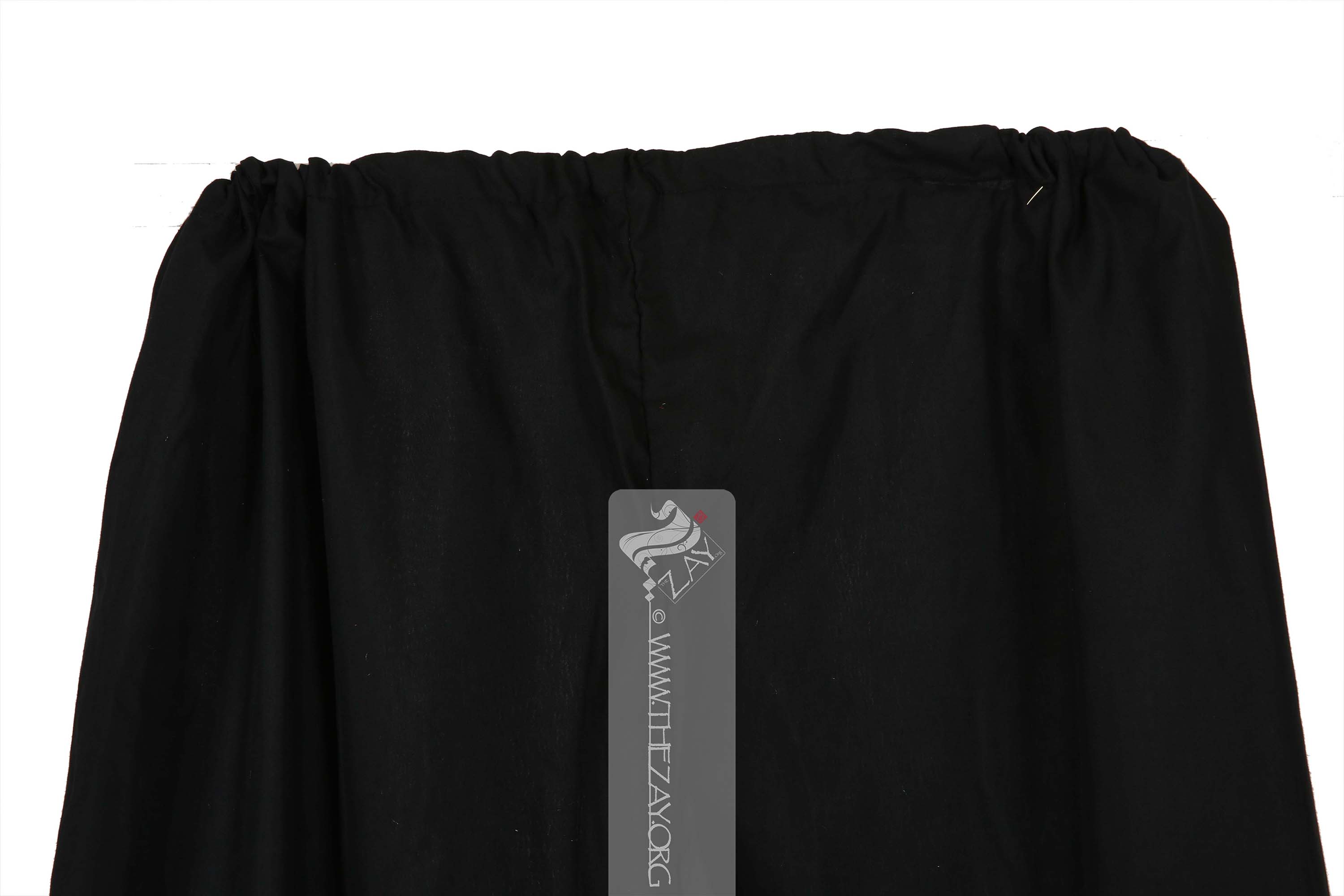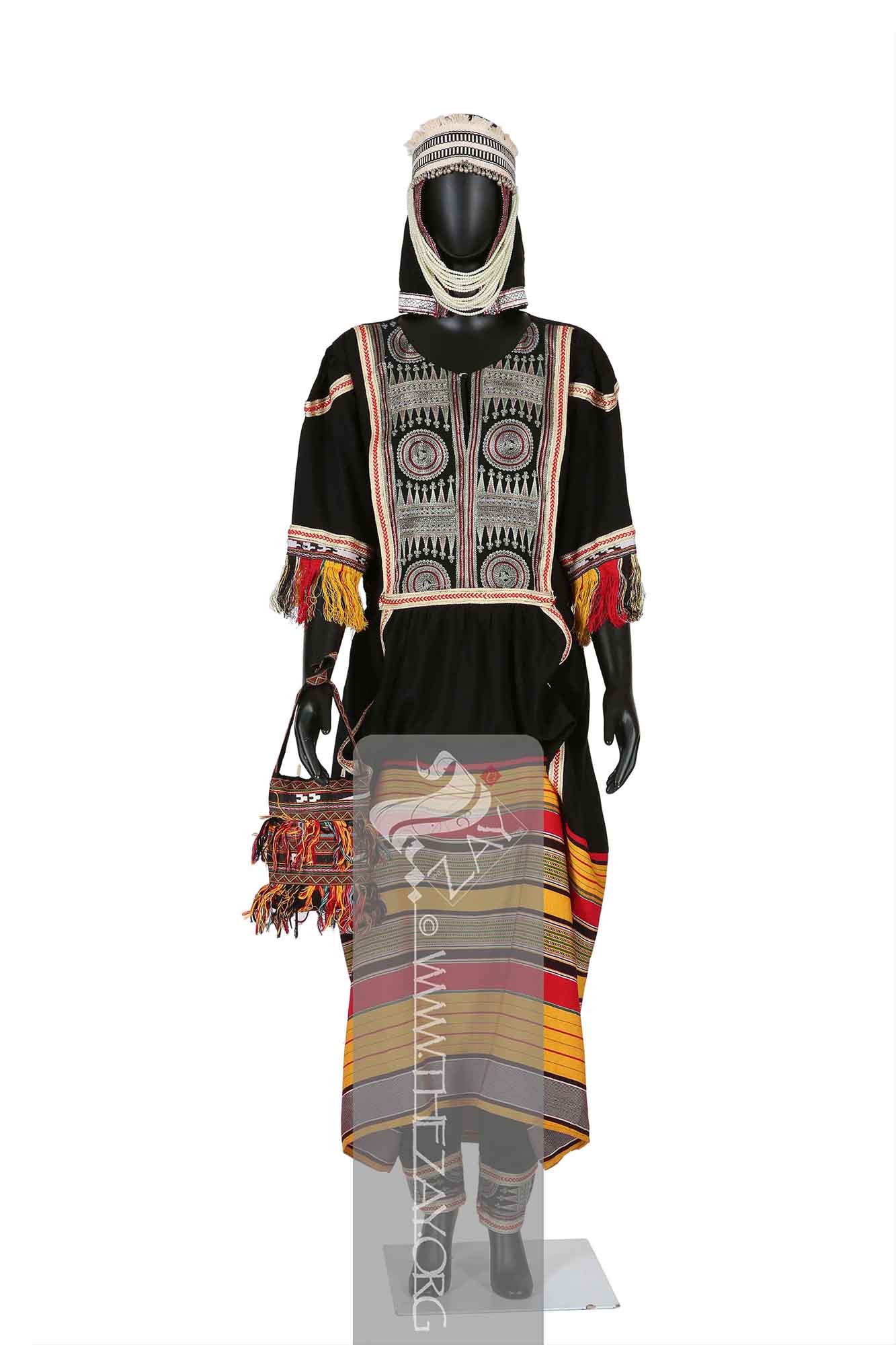Object NoteThis piece (
sirwal
Sirwāl: (Farsi: shalvār; Synonym: Salwar, Ṣarwāl, sharwāl, salbāl, khalag), pair of trousers with tapering ankles and fastened with a draw string. Believed to have originated in Central Asia it has spread since in the Indian subcontinent between c. 1st – 3rd century BCE and the Middle East from c. 12th century. ) is one part of a five-part ensemble including: dress (
thawb_al_sawn
Thawb_al_ṣawn: (Arabic: ṣāna: maintain and protect), colloquially refers to a dress worn by Bani Malik tribe, Saudi Arabia. It’s made of plain cotton, recently of satin, and has the shape of a narrow rectangle.) (
ZI2021.500946.1 KSA), headdress (
quba
Qub’a / Qūba’a: (Pl. 'aqbā'a), the part of the clothing that covers the head, a hat and a cap.’ah) (
ZI2021.500946.1b KSA), headband (‘usabah) (
ZI2021.500946.1c KSA), and flask (
ZI2021.500946.1d KSA). This outfit was purchased together with two other full outfits, Harb tribe
thawb
Thawb: (Arabic: thawb, Pl. Athwāb/thībān), can be pronounced thobe
Thobe: (Arabic: thawb, Pl. Athwāb/thībān), can be pronounced thawb or tobe
Tobe: (Arabic: thawb, Pl. Athwāb/thībān), can be pronounced thawb or thobe based on locale. The standard Arabic word for ‘fabric’ or ‘garment’. It can refer to a qamīs-like tunic worn by men and women in the Arabian Peninsula, Iraq, the southern and south-western ports and islands of Iran, and some countries in East and West Africa. More specifically, it can refer to the square-shaped Bedouin overgarment worn by women. based on locale. The standard Arabic word for ‘fabric’ or ‘garment’. It can also refer to a qamīs-like tunic worn by men and women in the Arabian Peninsula, Iraq, the southern and south-western ports and islands of Iran, and some countries in East and West Africa. More specifically, it can refer to the square-shaped Bedouin overgarment worn by women. or tobe
Tobe: (Arabic: thawb, Pl. Athwāb/thībān), can be pronounced thawb or thobe based on locale. The standard Arabic word for ‘fabric’ or ‘garment’. It can refer to a qamīs-like tunic worn by men and women in the Arabian Peninsula, Iraq, the southern and south-western ports and islands of Iran, and some countries in East and West Africa. More specifically, it can refer to the square-shaped Bedouin overgarment worn by women. based on locale. The standard Arabic word for ‘fabric’ or ‘garment’. It can also refer to a qamīs-like tunic worn by men and women in the Arabian Peninsula, Iraq, the southern and south-western ports and islands of Iran, and some countries in East and West Africa. More specifically, it can refer to the square-shaped Bedouin overgarment worn by women in the Arabian Gulf region. (ZI2021.500946.2 KSA) and Hijazi bridal
thawb
Thawb: (Arabic: thawb, Pl. Athwāb/thībān), can be pronounced thobe
Thobe: (Arabic: thawb, Pl. Athwāb/thībān), can be pronounced thawb or tobe
Tobe: (Arabic: thawb, Pl. Athwāb/thībān), can be pronounced thawb or thobe based on locale. The standard Arabic word for ‘fabric’ or ‘garment’. It can refer to a qamīs-like tunic worn by men and women in the Arabian Peninsula, Iraq, the southern and south-western ports and islands of Iran, and some countries in East and West Africa. More specifically, it can refer to the square-shaped Bedouin overgarment worn by women. based on locale. The standard Arabic word for ‘fabric’ or ‘garment’. It can also refer to a qamīs-like tunic worn by men and women in the Arabian Peninsula, Iraq, the southern and south-western ports and islands of Iran, and some countries in East and West Africa. More specifically, it can refer to the square-shaped Bedouin overgarment worn by women. or tobe
Tobe: (Arabic: thawb, Pl. Athwāb/thībān), can be pronounced thawb or thobe based on locale. The standard Arabic word for ‘fabric’ or ‘garment’. It can refer to a qamīs-like tunic worn by men and women in the Arabian Peninsula, Iraq, the southern and south-western ports and islands of Iran, and some countries in East and West Africa. More specifically, it can refer to the square-shaped Bedouin overgarment worn by women. based on locale. The standard Arabic word for ‘fabric’ or ‘garment’. It can also refer to a qamīs-like tunic worn by men and women in the Arabian Peninsula, Iraq, the southern and south-western ports and islands of Iran, and some countries in East and West Africa. More specifically, it can refer to the square-shaped Bedouin overgarment worn by women in the Arabian Gulf region. (ZI2021.500946.3 KSA).
Object History Once our Digital Archive launched in 2019, people began to reach out to donate, sell, or point out interesting outfits and body adornments to The
Zay
Zay: (Arabic: costume, Pl. azyaā’), a set of clothes in a style typical of a particular country or historical period. team. When the webinar (Traditional Costumes and Heritage of Saudi Arabia) aired in July of 2021, Mr. Zakaria Ahmed, silver and antique dealer from Yemen and close supporter of The
Zay
Zay: (Arabic: costume, Pl. azyaā’), a set of clothes in a style typical of a particular country or historical period. Initiative’s work, managed to source three interesting and complete outfits through his personal connections throughout the region. Though not the highest of quality,
Dr. Reem Tariq
Ṭariq: (Arabic; Synonym: tulle_bi_talli
Tūlle_bi_tallī: (French: Tulle – a city in France where fine material for veil was first made; Turkish: tel – wire; Synonym: tariq; talli; badla; khus_dozi ), series of small metal knots made on a woven net ground as embellishment. The term is commonly used in the North African Arab region specifically in Egypt.
; talli; badla; khus_dozi ), series of small metal knots made on a woven net ground as embellishment. The term is commonly used in the Levant Arab region specifically in Lebanon.
El Mutwalli
Dr. Reem Tariq
Ṭariq: (Arabic; Synonym: tulle_bi_talli
Tūlle_bi_tallī: (French: Tulle – a city in France where fine material for veil was first made; Turkish: tel – wire; Synonym: tariq; talli; badla; khus_dozi ), series of small metal knots made on a woven net ground as embellishment. The term is commonly used in the North African Arab region specifically in Egypt.
; talli; badla; khus_dozi ), series of small metal knots made on a woven net ground as embellishment. The term is commonly used in the Levant Arab region specifically in Lebanon.
el Mutwallī: Founder (CEO) of the Zay
Zay: (Arabic: costume, Pl. azyaā’), a set of clothes in a style typical of a particular country or historical period. Initiative, a public figure, speaker and author. An expert curator and consultant in Islamic art and architecture, interior design, historic costume, and UAE heritage. was very quick to acquire and add them to augment the Saudi section of The
Zay
Zay: (Arabic: costume, Pl. azyaā’), a set of clothes in a style typical of a particular country or historical period. Collection.
Object Features This undergarment (
sirwal
Sirwāl: (Farsi: shalvār; Synonym: Salwar, Ṣarwāl, sharwāl, salbāl, khalag), pair of trousers with tapering ankles and fastened with a draw string. Believed to have originated in Central Asia it has spread since in the Indian subcontinent between c. 1st – 3rd century BCE and the Middle East from c. 12th century. ) is made from the same black cotton material as the matching dress (
thawb_al_sawn
Thawb_al_ṣawn: (Arabic: ṣāna: maintain and protect), colloquially refers to a dress worn by Bani Malik tribe, Saudi Arabia. It’s made of plain cotton, recently of satin, and has the shape of a narrow rectangle.). These pants are long, straight-legged, and wide-seated, stretching from the waistline and ending at the ankle. Typically, the matching dress is worn pulled and lifted towards the waist, where it is tucked into the waistband of the
sirwal
Sirwāl: (Farsi: shalvār; Synonym: Salwar, Ṣarwāl, sharwāl, salbāl, khalag), pair of trousers with tapering ankles and fastened with a draw string. Believed to have originated in Central Asia it has spread since in the Indian subcontinent between c. 1st – 3rd century BCE and the Middle East from c. 12th century. , so the ankle cuffs become visible.
This more modern version uses an elasticated waist, instead of the traditional drawstring cords, referred to as (
dikkah
Dikkah: (Arabic: belt), a drawstring or cotton cord used to fasten the waistline on underpants (sirwal
Sirwāl: (Farsi: shalvār; Synonym: Salwar, Ṣarwāl, sharwāl, salbāl, khalag), pair of trousers with tapering ankles and fastened with a draw string. Believed to have originated in Central Asia it has spread since in the Indian subcontinent between c. 1st – 3rd century BCE and the Middle East from c. 12th century. ). Also known as (ribqah
Ribqah: (Arabic: noose, pl. ribaq), colloquially in Saudi Arabia, it refers to the cotton cord used to fasten the waistline on underpants (sirwal
Sirwāl: (Farsi: shalvār; Synonym: Salwar, Ṣarwāl, sharwāl, salbāl, khalag), pair of trousers with tapering ankles and fastened with a draw string. Believed to have originated in Central Asia it has spread since in the Indian subcontinent between c. 1st – 3rd century BCE and the Middle East from c. 12th century. ). Also known as (dikka), or (nis’ah).), or (nis’ah
Nis’ah: (Arabic: diminutive of nis’ah: belt), a woven cotton or wool spun flat cord, used to gather and fasten underpants (sirwal
Sirwāl: (Farsi: shalvār; Synonym: Salwar, Ṣarwāl, sharwāl, salbāl, khalag), pair of trousers with tapering ankles and fastened with a draw string. Believed to have originated in Central Asia it has spread since in the Indian subcontinent between c. 1st – 3rd century BCE and the Middle East from c. 12th century. ) around the waist. Also known as (ribqah
Ribqah: (Arabic: noose, pl. ribaq), colloquially in Saudi Arabia, it refers to the cotton cord used to fasten the waistline on underpants (sirwal
Sirwāl: (Farsi: shalvār; Synonym: Salwar, Ṣarwāl, sharwāl, salbāl, khalag), pair of trousers with tapering ankles and fastened with a draw string. Believed to have originated in Central Asia it has spread since in the Indian subcontinent between c. 1st – 3rd century BCE and the Middle East from c. 12th century. ). Also known as (dikka), or (nis’ah).), or (dikkah). The term is also used to denote any chevron motif.).), (
ribqah
Ribqah: (Arabic: noose, pl. ribaq), colloquially in Saudi Arabia, it refers to the cotton cord used to fasten the waistline on underpants (sirwal
Sirwāl: (Farsi: shalvār; Synonym: Salwar, Ṣarwāl, sharwāl, salbāl, khalag), pair of trousers with tapering ankles and fastened with a draw string. Believed to have originated in Central Asia it has spread since in the Indian subcontinent between c. 1st – 3rd century BCE and the Middle East from c. 12th century. ). Also known as (dikka), or (nis’ah).), or (
nis’ah
Nis’ah: (Arabic: diminutive of nis’ah: belt), a woven cotton or wool spun flat cord, used to gather and fasten underpants (sirwal
Sirwāl: (Farsi: shalvār; Synonym: Salwar, Ṣarwāl, sharwāl, salbāl, khalag), pair of trousers with tapering ankles and fastened with a draw string. Believed to have originated in Central Asia it has spread since in the Indian subcontinent between c. 1st – 3rd century BCE and the Middle East from c. 12th century. ) around the waist. Also known as (ribqah
Ribqah: (Arabic: noose, pl. ribaq), colloquially in Saudi Arabia, it refers to the cotton cord used to fasten the waistline on underpants (sirwal
Sirwāl: (Farsi: shalvār; Synonym: Salwar, Ṣarwāl, sharwāl, salbāl, khalag), pair of trousers with tapering ankles and fastened with a draw string. Believed to have originated in Central Asia it has spread since in the Indian subcontinent between c. 1st – 3rd century BCE and the Middle East from c. 12th century. ). Also known as (dikka), or (nis’ah).), or (dikkah). The term is also used to denote any chevron motif.), that were used in the past.
The ankle bands are wide enough to allow the feet to pass through, they are decorated with the same style of machine embroidery found on the accompanying dress, with red, green, and orange metallic thread in geometric motifs. The motifs include medallions, small circles, triangles, and rectangular lines. The machine embroidery is applied first on a black cotton fabric then the fabric is
appliqued
Appliqued: (French: appliquer – Apply), ornamental needlework where small pieces of decorative fabric are sewn on to a larger piece to form a pattern. to the ankle bands. It is then hemmed with two strips of ready-made golden trim with a central line of repeated red chevron motif.




